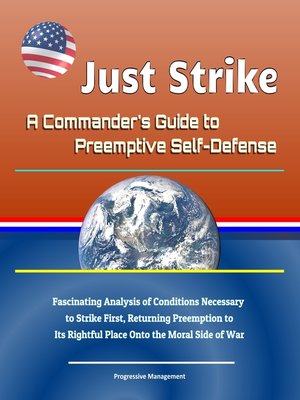Just Strike
ebook ∣ A Commander's Guide to Preemptive Self-Defense--Fascinating Analysis of Conditions Necessary to Strike First, Returning Preemption to Its Rightful Place Onto the Moral Side of War

Sign up to save your library
With an OverDrive account, you can save your favorite libraries for at-a-glance information about availability. Find out more about OverDrive accounts.
Find this title in Libby, the library reading app by OverDrive.



Search for a digital library with this title
Title found at these libraries:
| Library Name | Distance |
|---|---|
| Loading... |
This mid-2018 report has been professionally converted for accurate flowing-text e-book format reproduction. The imminence requirement for preemption can make all the moral difference in deciding to launch a lethal strike. Influenced by Michael Walzer's just war criteria for preemption, I provide three necessary conditions to strike first in self-defense. A commander must justifiably believe three things: that an unjust aggressor is poised to attack, that her capacity to avert an attack is constrained by an imminent decision point or last window of opportunity, and that preemption is part of a moral-risk proportionate strategy. In any event, a commander must decide to preempt or not preempt under conditions of uncertainty.
Imminence must be seen as a necessary requirement for preemption, which is the term normative theorists use when an unjust aggressor poses an imminent threat of attack, and a defender strikes first in self-defense. Insofar as a defender foresees an imminent threat and need not await her fate before taking action, preemption can be just. If preemption is just—if pre-strike conditions underwrite the other requirements of just war action (liability, necessity, and proportionality) — then a defender would not morally wrong an aggressor by striking first.
Regrettably, outside of normative theory, when the conditions did not warrant a preemptive strike, past invocations of the term preemption have compromised our nomenclature. Since at least the time of the 2003 U.S. war in Iraq, preemption has suffered from a conceptual hangover. Due to wanton abuse by national leaders who eschewed a false narrative to justify war, preemption roiled in a dive bar of fear, conceptual conflation, and a consort of connotation.
I. Introduction * Ii. A Weak Concept Of Imminence * Iii. Credible Threat Condition * A. Resolve And Capability * B. Near Certainty As A Justifiable Belief * C. Just War Requirements * D. Liability To Defensive Harm * Iv. Temporal Necessity Condition * A. Two Necessary Conditions For Imminence * B. Imminence As A Last Window Of Opportunity * V. Proportionate Strategy Condition * A. Proportionality And Moral Risk * B. Commander Uncertainty * C. Expected Value And Moral Risk * 1. Moral Lens * 2. Strategy Comparison * 3. Non-Moral Lens * Vi. Conclusion







